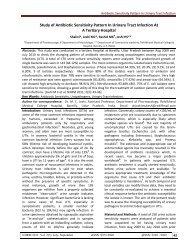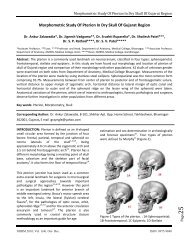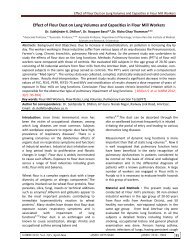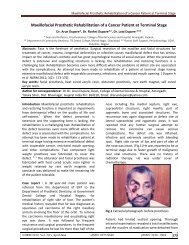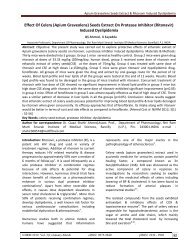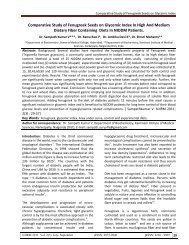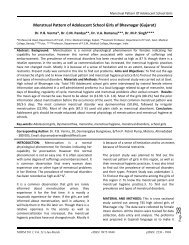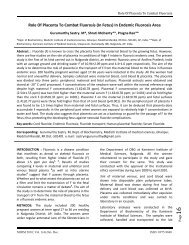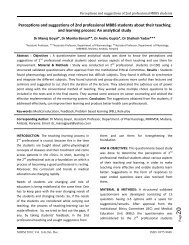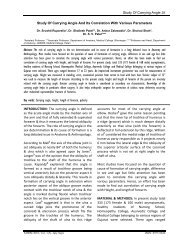Study Of Femoral Neck Anteversion 7 Study Of Femoral Neck ... - njirm
Study Of Femoral Neck Anteversion 7 Study Of Femoral Neck ... - njirm
Study Of Femoral Neck Anteversion 7 Study Of Femoral Neck ... - njirm
Create successful ePaper yourself
Turn your PDF publications into a flip-book with our unique Google optimized e-Paper software.
femoral neck axis and the femoral condylar<br />
axis 10 . Hence estimation of anteversion on dry<br />
bone is still considered the most accurate<br />
method.<br />
There are few studies done in India before this<br />
study. Western studies results are not<br />
applicable in Indian population because<br />
femoral anteversion differs in both<br />
populations 11 .<br />
The mean anteversion in male bones was 7.2°<br />
and 14.3° on the left and right sides<br />
respectively averaging to about 10.9°. In<br />
females, it was 10.5° and 16.4° on the left and<br />
right side respectively averaging 13.6° in<br />
females. This significant bilateral limb<br />
asymmetry should discourage the tendency to<br />
view the lower limbs as mirror images of one<br />
Western<br />
studies<br />
Indian<br />
studies<br />
<strong>Study</strong> <strong>Of</strong> <strong>Femoral</strong> <strong>Neck</strong> <strong>Anteversion</strong> 10<br />
another. Statistical analysis revealed sexual<br />
dimorphism in anteversion (Table-1) in Indians<br />
being greater in the females as compared to<br />
males. A statistically significant difference was<br />
found for the angle of anteversion between the<br />
male-and female-type bones and the right- and<br />
left-sided bones. The average female-type bone<br />
was about 3° higher than the average maletype<br />
bone. Parsons et al 12 . had also<br />
documented anteversion to be greater in<br />
females. Similarly, Kingsley and Olmsted9<br />
observed a negligible difference (0.081°), and<br />
Yoshioka et al 8 . found a difference of 1° (Table-<br />
3). However, no tests of significance were done<br />
in these series. Kate BR et al 13 . done study on<br />
Indian femur found lesser average angle of<br />
anteversion as compared to present study<br />
(Table-3).<br />
Table-3 <strong>Femoral</strong> anteversion as observed by other researchers<br />
Researcher Sample Mean angle of anteversion in degree<br />
size Right Left Average<br />
Yoshioka Y et al 8 . (1987) 32 - - M-7 .F-8<br />
Kingsley PC et al 9 . (1948) 630 M-8.54, F-7.47 M-7.94, F-8.11 8.02<br />
Parsons FG et al 12 . (1914) 266 M-13.0, F-18.0 M-13.0, F-16.0 15.3<br />
Kate BR et al 13 . (1976) 108 9.0 8.6 8.8<br />
Present study (2005) 92 M-7.2, F-10.5 M-14.3, F-16.4 12.4<br />
Because Indians are more apt to participate in<br />
floor level activities, in contrast to persons in<br />
the West, our hips have to be evolutionally<br />
different from theirs. Thus, the same procedure<br />
produces a different outcome in our<br />
population. Hence a population-specific<br />
protocol and assessment criteria must be<br />
devised. A femoral component of a total hip<br />
replacement should be in an anteversion angle<br />
that closely represents the anteversion angle<br />
for the Indian population to achieve the best<br />
surgical results. In India with the increasing<br />
demand for total hip replacement, this<br />
anteversion angle becomes more significant.<br />
Therefore, our study was undertaken to<br />
ascertain the average angle of anteversion of<br />
the femoral neck in Indian subjects.<br />
CONCLUSIONS: The average angle of<br />
anteversion obtained on dry bone was 12.4°<br />
NJIRM 2010; Vol. 1(3). July-Sept. ISSN: 0975-9840



